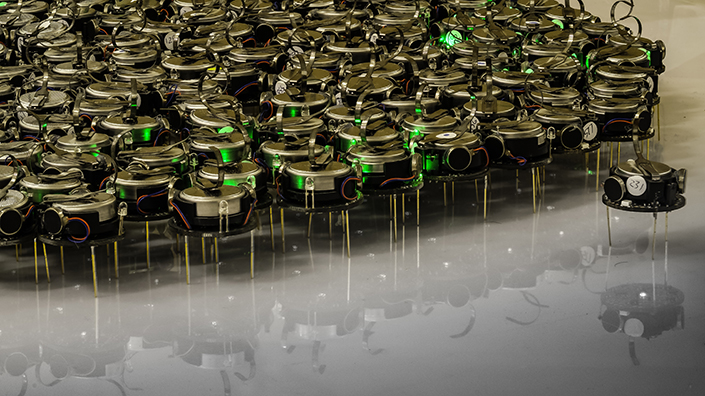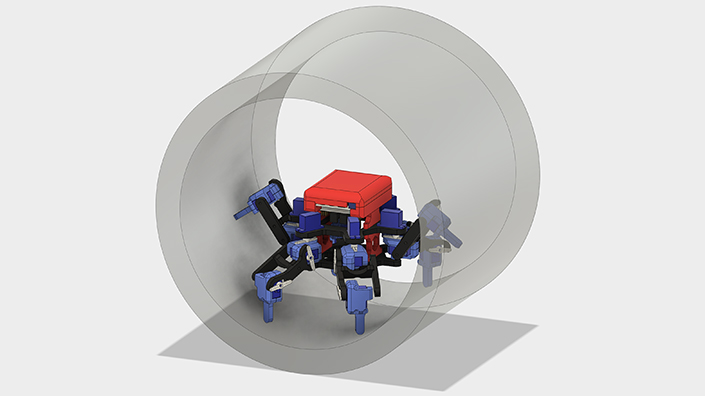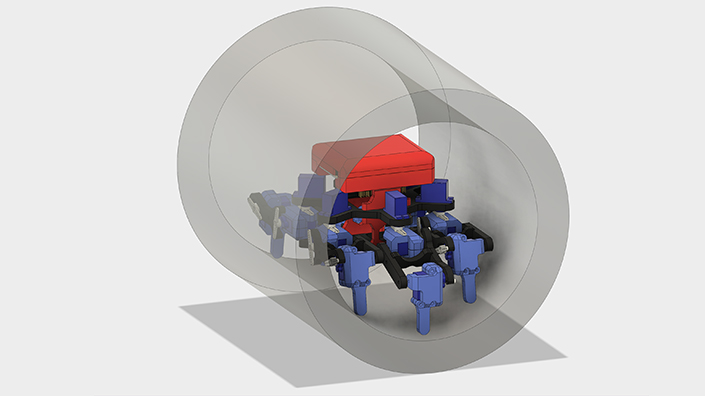Such swarms are being studied by teams from the European Molecular Biology Laboratory in Barcelona and the University of Bristol’s Robotics Laboratory. The robots communicate with a process that mimics morphogenesis – the biological process by which cells communicate to form all kinds of shapes, ranging from spots on a leopard to the shape of a human hand.
The team from Bristol programmed swarms of 300 coin-sized micro-robots to interact in simple localised ways, to see if they could autonomously reproduce the kind of ordered structures found in biology. The disc-shaped machines use infrared signals to exchange the digital equivalent of biological chemicals called morphogens. Using tiny legs, the robots move into dense concentrations that begin to grow extrusions – like limbs reaching out and exploring their environment.
“What’s really exciting about this work is these shapes are fully self-organised,” says Sabine Hauert, joint project leader at the Bristol Robotics Laboratory. “That means there’s no leader in the system. We haven’t given them a grand plan of a shape to create but those shapes emerge in quite a repeatable manner, just based on these simple rules.”
The researchers think such biologically inspired robot swarms could find applications in fields as diverse as healthcare and search and rescue. “You’d have a bag of these on the rescuers’ backpacks,” says Hauert, “and they could spill them and they’d create these trails between the victims and the rescuers.”

She also predicts nano-scale systems, where swarms of nano-bots exploring the body could lead to better forms of cancer treatment. A third application could be civil engineering, particularly in disaster relief situations where swarms of robots could self-assemble to build temporary structures such as bridges, which would automatically adjust their shape to fit any building or terrain.
This self-adapting and self-repairing nature is one of the most promising areas of research. “These systems are quite robust to changes in the environment and damage done to them,” says Hauert. “If we take off one of these limbs there’s no signal saying it has been taken off but that’s fine, because the next robot is going to reposition itself at the end of that tip and regrow the limb quite naturally.”
Likewise if one of the robots malfunctions during the experiments, or if the researchers move, split or block the swarm, the robots naturally redistribute themselves, adapting autonomously to the changes. “The robots just continue following their simple set of rules and do what they’re supposed to be doing… if they can’t physically do that then the robots who were meant to be there go somewhere else,” says Hauert.
Bridging the gap
One of the challenges is how to adjust the simple rules to build specific shapes. Changing certain programming parameters, such as the time spent completing certain tasks, can lead to longer limbs, which could have applications in exploring large areas. Other parameter changes create smaller shapes with lots of tiny branches, which might be useful for searching smaller areas very thoroughly. “We need to do quite a lot of research in terms of understanding what shapes to generate,” says Hauert. “What are the right applications with respect to those shapes?”
One of the applications she sees in the short term is swarms of micro-robots that could spread over bridges and quickly monitor them for structural integrity. Other applications might be swarms of sensors that light up in different ways to indicate water quality, or swarms used in warehouses to help with logistics.
“It’s quite exciting,” says Hauert. “We have this combination of robots being robust enough to work in the real world and swarms that can now work in large numbers. So I feel the time is right to start using swarm technology. But seeing full-blown morphogenesis in the real world – that’s probably going to take more work.”
Creaking bridges, shattered roads – micro-robots could have the biggest impact in damaged environments. One of their biggest applications could be right beneath our feet.
Incy wincy robots
Beneath the UK’s roads there is a network of roughly 1m kilometres of pipes, many of them old and decaying faster than they can be repaired. Fixing these pipes leads to 1.5m roadworks a year, costing £5.5bn – not to mention all the headaches from so many traffic jams. Something clearly needs to be done.
A potential solution from the government, perhaps surprisingly, has been to invest several million pounds into researching tiny robot spiders. Swarms of these autonomous six-legged machines, as small as a centimetre, would crawl through our network of pipes, constantly monitoring them for defects and breakages.

Six-legged 'spiders' will crawl through utility pipes to check for blockages and leaks
“We have proved it is feasible with a very few autonomous robots, maybe between 10 and 20, to inspect a system of pipes covering a small residential community every two weeks,” says the University of Sheffield’s Professor Kirill Horoshenkov, the leader of a four-university team given government funding to carry out the research. “We found that they could broadcast data on the conditions of these pipes on a much more regular basis than anything which currently exists.”
The robots performing this unpleasant task would crawl through the pipes using sonar to detect defects and blockages. These ‘inspection bots’ could then call for ‘worker bots,’ which could spray polymers to seal cracks or use high-powered jets to remove built-up sediment. “Automation will be the key,” says Horoshenkov. “That’s the biggest step change from the current practice. Current practices refer to robots but these are actually controlled by a human sitting in a van on the side of the road.”
To be fully autonomous the robots will need to communicate with each other, mostly through sound and radio waves. Radio waves could be used in sewer pipes, which are mainly air, but, in clean water pipes where radio waves do not propagate well, sound waves could be used. The team is working on getting three of its large prototypes – they can fit inside a 0.3m-diameter pipe – to communicate with each other. But they hope to soon test co-operation with swarms of hundreds of robots inside realistic buried facilities provided by utility companies.
Pipe dream
The research, carried out by teams from the universities of Sheffield, Bristol, Birmingham and Leeds, is still in its very early stages. Some of the biggest challenges to overcome, Horoshenkov believes, will be in integration, navigation and robustness.
Navigation could be an issue because GPS doesn’t penetrate far enough into the ground to provide accurate positioning. There is also little research on navigating underground pipe systems, and the pipes themselves form a relatively featureless environment. “The challenge is to develop a map,” says Horoshenkov, “and this map is remembered by the robots or we can communicate it to them, because the quality of the data depends on the accuracy of their position.”
The researchers are looking at ways of making the robots disposable, so if one fails it is small enough and safe enough to be disposed of by the water system itself. The machines need to consist of materials that satisfy industry requirements, such as galvanised steel, copper or PVC, so they don’t jeopardise water quality or the environment. “We are teaming up with key industry players to make sure that they are happy to put these agents inside their water pipes,” says Horoshenkov.

The team plans to start trialling the robots in two years, first in laboratory conditions, then in realistic test sites within five years. But real-world adoption could take as long as 10 years, partly owing to the timeframes in which utility companies are regulated. Despite the long wait, Horoshenkov is confident that robots, in some form or other, will make their way into our underground pipes.
In the meantime there are other avenues to explore. One surprising application could be healthcare, where the team’s micro-robots could be injected into patients’ bodies to explore a very different network of pipes, feeding back important bio-data much the same as they would in the underground water system.
Whatever the future holds for the swarm, it has already started assembling.
On the job
Last December the government announced a £26.6m investment into robotics for civil engineering purposes. Some £7m of this money will go directly into funding research on micro-robots that will monitor and repair underground pipes.
A further £19.6m will go, through the Industrial Strategy Challenge Fund, to researching robots that could be sent into hazardous environments such as offshore windfarms, undersea oil pipelines and nuclear decommissioning facilities. As well as robots, other technologies will be tested, such as AI software on satellites to check when repairs are needed, or drones for oil pipeline monitoring.
The funding is part of the government’s industrial strategy, which aims to use new technologies to create highly skilled jobs and improve workplace health and safety, much of which will directly affect engineers and engineering jobs.
“There may be a period where people have to be retrained,” says project leader Professor Kirill Horoshenkov. “But somebody has to produce these robots, somebody has to maintain them, somebody has to optimise data from these robots, and somebody has to understand this technology to develop it further. So it’ll mean more jobs, not less, and better-quality ones.”
Content published by Professional Engineering does not necessarily represent the views of the Institution of Mechanical Engineers.